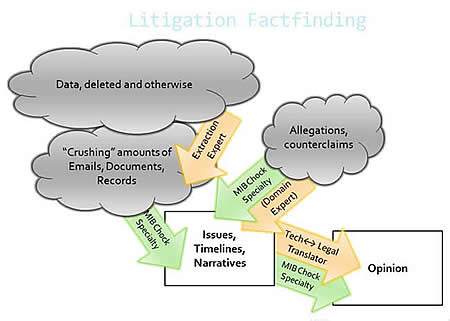Forensic Research & Expert Witness Consulting
Our extensive experience and expertise in forensic research and expert witness consulting has made a difference in the outcome in dozens of cases since 2004, including court cases and cases we saved from requiring litigation. Case studies referenced below provide you a sampling of the scope of our assistance and experience..
How We Help:
- Expert Data Extraction – a specialty of M.I.B. Chock, LLC. Many of our cases have required that we develop our own tools for fast analysis of large quantities of data. Far too frequently clients’ initial data comes to us completely out of context, and often from the wrong time frame, addressing irrelevant topics rather than the issues under litigation. We’re frequently able to redirect the investigation to areas more useful to our client to pursue – or reasons to settle more quickly.

- Expert Research and Analysis for Clarity, Timeliness and Narrative.
Individual and team-based forensic research, analysis and expert witness are part of our services as required for each specific case. Our expert witness teams may include other specialists such as data capture experts, lawyers, translators of Information Technology (IT) issues to legal issues, and other domain experts such as specialists in certain programming languages or the litigants’ industries. Working individually or as a team, as appropriate, we establish what actually happens in IT-related cases: who, what, when, where, how and why.
- Translation from Technical to Legal.
Upon completion of all technical analysis and research, the real issues of each case are extracted and put into context, in an understandable form, and with reference to the relevant documents.
- Closing A Case Quickly
Taking a broad view of each case lets us spot critical issues in unexpected parts of the data. For example, we sometimes save clients significant expense by identifying issues that can close a case quickly::
“Um, there’s a serious logic flaw in your comparison of these two patents.”
“Yes, it’s true that he billed far above his estimate, but he submitted time sheets every week, and your employee signed every one of them.”
“I know I’m supposed to be evaluating this elaborate claim of intellectual property value, but look – people stopped paying your claimant for this type of service twenty years before the disaster.”
“There was nothing wrong with the vendor’s technology. The main problem was your client’s project manager. You’d better settle fast!” (Unfortunately, this advice was ignored).
Most of our cases fall within these three general categories:
Some additional problem areas are listed as well.
System Development Failure
Contract Violations, Unfulfilled Promises. Clients Trying to Defraud Vendors, Clients Losing Track of Contractual Obligations and more.
In our System Development cases, project records, emails, etc. are analyzed to determine what happened during the development of an information technology system, where problems arose and why. We determine whether the system developer failed to perform according to professional standards or whether the client is the primary cause of the problem.
FAULT:
Nonprofit Donations Tracking Software
Using graphically illustrated evidence, we demonstrated why the development of a donations tracking system would probably never come to a successful conclusion. We were also able to demonstrate that the developer was consistently misrepresenting the facts to the client about project completion.
INNOCENCE:
Wholesaler Enterprise Resource Planning /Warehouse Management Implementation
Determined that an accounting software reseller had performed adequately on a project integrating accounting with a warehousing system – and that the unhappy customer had forgotten signing a contract with another company altogether to provide the project management services at issue.
NEGLIGENCE:
Electronics Distributor Enterprise Resource Planning (ERP) Implementation
Found negligence by several vendors, who caused delays in development, and finally allowed the system to “go live” before it was ready, with no way to go back, leading to bankruptcy within the year.
Chiropractor’s Accounting System
Found gross negligence not in the software, but in the supporting accounting services for a chiropractor that resulted in bankruptcy within a few months.
FRAUD:
Hospital Emergency Room Medical Records
Demonstrated abuse of testing procedures by a hospital which was attempting to discredit a medical records system vendor, to avoid paying for extensive custom software development.
Property & Casualty Insurance System
Showed that developers lacked the industry-defined level of capability claimed in their advertising. They lost customer requirements, mixed up the versions of software they were developing, and failed to test in a realistic environment, resulting in their client’s customers receiving garbled policies.
INCOMPETENCE:
Workman’s Compensation Insurance System
Demonstrated a software developer’s project management practices and understanding of workman’s compensation insurance to be inadequate to provide the systems and support needed by an insurance company.
Medical Office Workflow Software
A medical office hired a developer for a web-based workflow management system. Shortly afterwards, the developer fired its database management expert. When the budget ran out, the developer produced a set of beautiful screen designs, but gave no indication of how information could get from one to another. They said they’d need the same amount again to “finish” that part.
MORE CAUSES OF DEVELOPMENT FAILURE WE'VE FOUND
FAILING TO DEFINE CLIENT’S REQUIREMENTS:
Massively Multiplayer Game System
The developer assumed wrongly that they would run the massively multiplayer game system on their own computers, and failed to develop a system that the client could manage themselves.
Surgery Group Web Site
The developer never documented the specific requirements for the surgeons’ system – notably the back-end subcontractor had no concept of the HIPAA privacy requirements for handling patient data, using an insecure platform and later leaving the patient data exposed on an open Web site.
FAILING TO COMMUNICATE:
Wholesaler’s Information Technology Support
This dispute arose because the developer failed to submit an accounting of the activities their bills covered. We were eventually able to get detailed time records, and establish that they were justified given the capabilities of the system.
Clothing Manufacturers Apparel & Footwear System
The clothing manufacturer claimed that the vendor promised a fixed maximum cost, which the vendor exceeded. The vendor said the manufacturer’s changed requirements were responsible for the additional costs – but had failed to mention that they would require exceeding the limit. We found evidence that the vendor was deliberately spending at a rate far exceeding the plan schedule, intentionally too fast for their client to be able to react.
Municipal Sign Tracking & Maintenance System
This massive case started with an inexperienced project manager failing to respond to client questions and requests, then performing poorly. The second project manager used an informal methodology which he couldn’t convince the client was adequate. Monthly bills were delivered several months late. By the time the third project manager had things under control, the city’s manager was ignoring the project. We found evidence that the system was actually well underway, with promising results, but by that time the project had been canceled.
Health Food Web Site
Both client and developer were working on the same system, along with contractors from another company. Nobody was responsible for overseeing the project(s) as a whole.
AGREEING TO A FIXED SCHEDULE:
Information Technology Services Subcontract
Our client had induced an overseas developer to agree to deliver a project by a specified time, under penalty of paying for development by an American company instead. In the normal course of things, especially with an abusive client, the developer missed the deadline. We found, unhappily, that the developer was contractually responsible for paying much more than received for the project.
Security Software Suite Integration
The main point of dispute in this case was whether the developer had agreed to a fixed schedule or not – we had to parse wording in the contract, scope of work, and various emails to determine whether a firm commitment had finally been made after much argument.
Intellectual Property Disputes
Intellectual property disputes involve analyzing software source code, system design documents, and other materials to resolve intellectual property issues such as whether the IP had been copied from another source, or how much it had been modified from the original version.
HEALTHCARE SYSTEMS:
Data Exchange Software Developer vs. Internal Data Flow Software Developer
A developer of data exchange software provided it to a larger company for integration with their internal data flow software, then accused the large developer of various contractual, system development, financial, and customer relationship disruption issues. We developed a tool to compare multiple timelines of events related to the various problems to clarify what was happening.
Health Record Software Developer vs. Pharmacy Chain
Reviewed medical record patents, finding several for similar systems that predated the claimant’s.
Misappropriation of Radiology Software
Multiparty lawsuit – a radiology software vendor claimed that its proprietary software was shared with another vendor by its client or a prime contract when its contract with a radiology service provider was terminated.
Multimedia Developer vs. Healthcare Presentation Developer
Investigated dispute whether multimedia contribution was paid for or jointly owned.
INSURANCE & FINANCIAL SYSTEMS:
Small Insurance Agency vs. Large Insurance Agency
A large insurance agency offered the services of its software department and a reseller contract to a small agency with a specialized product. After several months, the large agency absorbed the smaller company’s product into its own product line, and terminated the reseller contract. We found components of the small company’s software in the large company’s – including comments with the small company’s name, and a copy of the small company’s software in the large company's copyright filing.
Investment Management Firm vs. Ex-Employees
Demonstrated that customer data had been manipulated by departing employees of an investment management firm in order to misappropriate royalty payments. Demonstrated that this took place at a time much earlier than the firm suspected.
Financial Advisor vs. Ex-Employees’ New Company
Matched old and new companies’ databases to find theft of client and prospect data both at the time the employees quit and several months earlier.
Credit Card Processing Software Plagiarism
Demonstrated plagiarism of one company’s credit card processing software by another software company.
Check Processing Software Ownership
Developed methods to evaluate the proportion of an old check-processing system represented in the latest versions of the software of a company to which the code had been licensed.
PATENTS:
System Inventor vs. Patent Office
Showed misinterpretation of software patent claims by the Patent Office.
“Patent Troll” vs. Various Web Services
Demonstrated logic error in the patent infringement claim.
Software Product Malfunctions
Some of our cases have required finding the flaws in a system that caused or could have caused harm to a healthcare patient.
Retail Pharmacy Software
Helped find a defect in a retail pharmacy system that allowed a mis-prescribed drug to remain on a patient’s prescription list.
Radiology Software
Showed that two supposedly integrated systems required a tricky manual interface that allowed an error that injured a patient.
Other issues
Disaster Victim vs. Utility
Determined that whatever the victim’s other losses, the intellectual property claim was for a line of services that hadn’t been bringing in revenue for at least a decade before the disaster.
Insurer vs. Computer Leasing Company
Helped outline procedures that would have helped an equipment inspector for a leasing company to have detected fraud by a client using “blinky boxes”.
Two Railroads vs. Air Quality District
Used two organizations’ own software and data to demonstrate trivially easy methods of fulfilling regulatory requirements they claimed would be onerous.
Regulators vs. Medical Doctor
Researched capabilities of a laboratory billing system, and demonstrated how their reports could have been faked by a laboratory rather than the physician.
Software Retailer vs. Recycle
Researched value of old software that was accidentally trashed.
Defense of Software Reseller
Researched methods of estimating packaged software prices at various times in the past.
Law Firm vs. Game Software Expert
Evaluated overbilling claims.
Insurance - Doctors vs. Benefits Provider
Reviewed software-based payments process.



